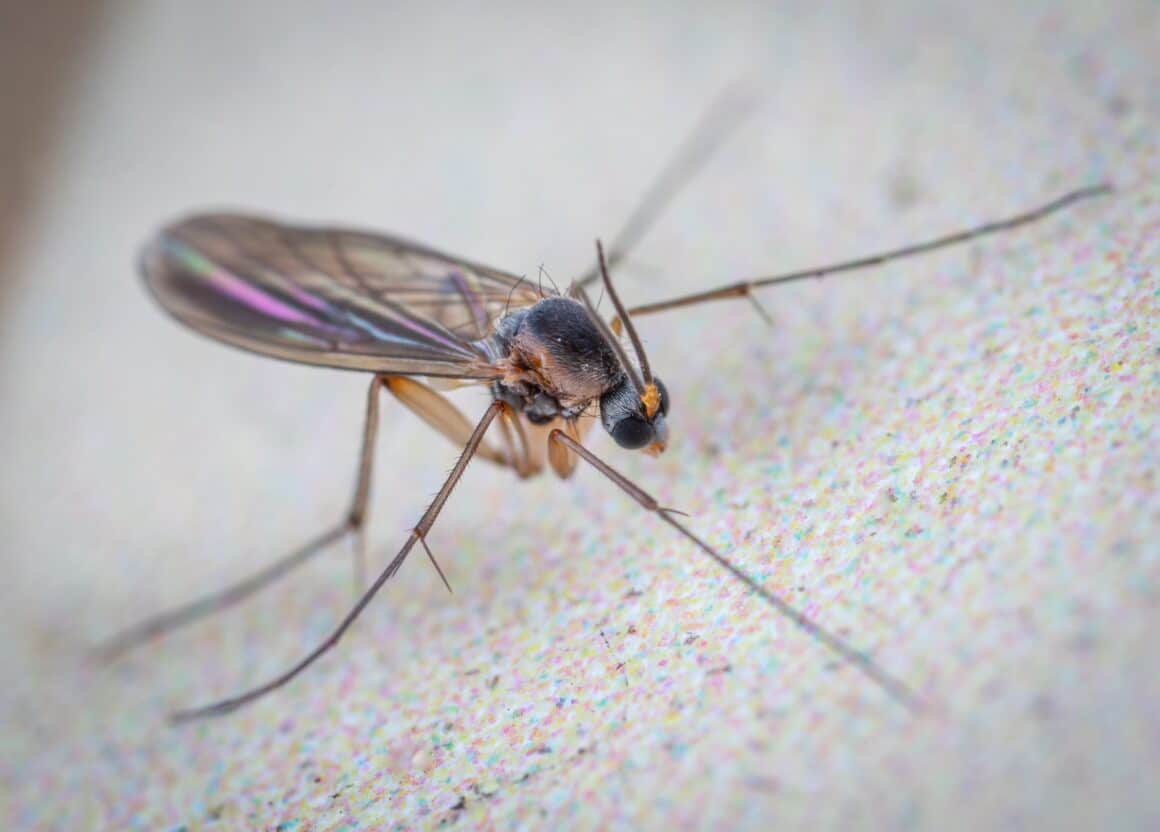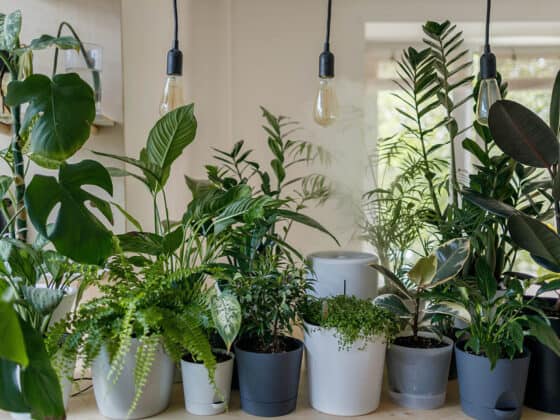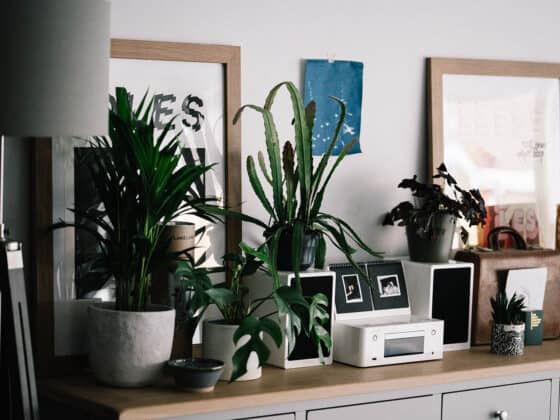One universal truth about houseplants is that if you own them, at some point, they are going to get fungus gnats. Not only are these flies one of the most common types of pests that plague our indoor plants, but they are also deceptively persistent and difficult to get rid of. But what exactly are fungus gnats?
Fungus gnats are small flies that infest potting soil and other container media, where they lay eggs and produce larvae that feed on fungi and other organic matter. If left untreated, they can destroy root systems, causing health issues or death to a plant. Luckily, there are several natural and low impact treatments to fight fungus gnat infestations.
If you ever notice tiny, black flies zooming around your houseplant, there is no need to panic. Although it is true that fungus gnat larvae can do some real damage to your plant, you usually have some time and a lot of options to knock back an infestation. In this article, we’ll cover what fungus gnats are, what they look like, and several ways you can treat for them once you’ve identified an issue.
What Do Fungus Gnats Look Like?
Let’s face it…most of us are all too familiar with fungus gnats! But, if you’re one of the lucky ones who has never had an issue with them (kudos to your watering game!), let’s go over what they look like.

Fungus gnats are very small flies that resemble a cross between a mosquito and a fruit fly. They tend to be long, delicate-looking bugs, about 1/16-1/8” in length. Their bodies are usually black and have light gray or clear wings.
Female gnats lay eggs in the soil that then hatch into larvae that are about 5mm in length, with clear or white bodies and distinctive black heads. You likely won’t notice larvae in the potting soil unless you know what to look for, so people usually first notice the adults flying around their houseplants.
Signs Your Houseplants Has Fungus Gnats
Likely, the first and most obvious sign your houseplant has a fungus gnat infestation is adult flies buzzing around the leaves and stems of your plant, crawling across the surface of the soil, or hovering around nearby windows. They are recognizable pests and will take flight any time you disturb your plant, like watering.
Less noticeable are the larvae that live in the soil. You might notice a bad infestation when digging in the potting mixture or transplanting to a new pot, but again, you’ll probably notice adults flying around the plant long before you think to check the soil.
If a fungus gnat infestation has persisted for a long time, you might notice your plant beginning to show signs of root rot despite not being overwatered. This is because the larvae in the soil feed on organic matter but will also begin to chew through the plant’s root system. As a result, you may see yellowing leaves beginning to show near the base, or the entire plant may begin to wilt.
How Do Fungus Gnats Damage Your Plant?
Because the adult flies are usually the first sign of an infestation, people often incorrectly assume they are the ones causing the most damage to the plant. In fact, while adult fungus gnats are considered to be a nuisance because they are annoying and unsightly, they do not actually do any damage to plants and do not bite humans. Their job is to mate and lay eggs in the soil so more larvae can be produced.
The little larvae crawling around in the soil are the actual threat! Mainly feeding on fungi and other decaying organic matter, fungus gnat larvae will also begin feeding on the tender roots of a plant. In large numbers, the larvae can decimate a root system in a matter of days or weeks.
Obviously, this disrupts the plant’s ability to take in water and absorb nutrients, so you begin to see the same symptoms of root rot in the plant, like yellowing leaves, drooping, or wilting.
Additionally, fungus gnat larvae can also spread pythium, a fungus-like microorganism that causes severe health issues for the plant, including stunted growth, wilting, and death. This condition is somewhat rare in houseplants but not out of the realm of possibility, which is why treating for fungus gnats is so important.
What is the Life Cycle of a Fungus Gnat?
Fungus gnats have a four-part life cycle starting with the eggs. Female flies lay clusters of eggs down in the potting soil of a houseplant. When the temperature reaches 75°F, the eggs hatch and produce larvae, which crawl through the soil and feed. They eventually form into pupae in anticipation of becoming adult flies, and after only a few days, emerge from the soil as fully formed adults. The adults live for about a week and will lay eggs to start the cycle over again.
This whole process, from egg laying to adulthood, takes approximately 17 days and can occur faster if the temperatures are warmer. This means that a population of fungus gnats can explode in just a few weeks.
It’s also interesting to note that because a single gnat’s life is lived mostly as a larva or pupa in the soil (and because adults don’t do any physical damage to the plant), this is where you should focus your treatments on controlling the population. Sprays and traps will only get you so far, but you need to treat the soil to eradicate the population.
How Do You Treat for Fungus Gnats?
If you’ve noticed you have a fungus gnat infestation in your home, the good news is that many different options for treatment are relatively low-impact. There are stronger chemical insecticides that can be deployed for near-instant eradication, but those methods aren’t conducive to indoor environments and are typically reserved for larger scale operations, like nurseries and greenhouses.
Instead, let’s go through several different methods to treat for fungus gnats. Most of these are natural and very safe to use in your home. And, in most cases, you can use several of these treatments together for better control of the problem.
Quarantine Your Plant
Although not technically a treatment option, moving your infested plant away from the rest of your houseplants is important to avoid any fungus gnats from spreading. Adult fungus gnats are generally pretty weak fliers, but they can travel from plant to plant when given the opportunity, so by isolating the infested plant, you can be sure the problem won’t spread while you are treating it.
Wait until your treatment options have run their course and there are no longer any signs of fungus gnats before you reincorporate your plant back into your collection.
Watch How You Water
Another big contributing factor to the hardiness of a fungus gnat population has to do with how much water the plant is receiving. Remember that these flies feed on the fungi and decayed matter in the potting soil, so if the plant is getting overwatered, it creates an environment where these food sources can explode. The increase in fungi and organic matter in the soil supports larger populations of gnats, so their numbers can grow quickly.
By allowing the soil to dry out and only watering when necessary, you can slow the speed at which the fungus gnat population grows, buying you more time to implement other treatment options. In my experience, reducing water alone will not eradicate all fungus gnats on your plant. It will certainly help, but you also run the risk of your plant being chronically underwatered, which comes with its own set of issues.
Yellow Sticky Cards
Another tool you can use to help monitor the fungus gnat population in a plant is to install a yellow sticky card amongst the stems to capture flying adults. I typically just put a small stake in the dirt and clip one of the cards to it using a clothespin.
These cards do two things. First, adult gnats will fly up against them and get stuck. This eliminates a portion of the population and can reduce the number of eggs getting laid in the soil. Like the watering technique, this can help keep a population in check but won’t likely eradicate all of the fungus gnats from a plant.
Secondly, sticky cards can be useful for monitoring a fungus gnat infestation over time. If you are seeing the number of adults trapped on the card drop week over week, your treatments are likely working. If that number increases at any point, you may need to try another tactic.
Apple Cider Vinegar Traps
An easy method of taking out flying adult fungus gnats is by luring them into a cider trap. Mix equal parts apple cider vinegar and water together in a small bowl, tuna can, or something similar. Add a few drops of dish soap and stir well. Place the container somewhere close to the plant (on top of the soil is preferred) and let it sit.
The smell of the apple cider vinegar attracts adult fungus gnats to the trap, while the soap breaks the surface tension of the liquid. As the flies land in the trap, they sink and drown in the liquid. Check the trap every few days and reset it with fresh apple cider vinegar and soap when needed.
Because this only targets adult flies, you will probably have to keep traps out for several weeks to catch newly emerged adults and consider another treatment option that targets the larvae.
Cut Potatoes
If you want to keep your fungus gnat controls all-natural, you can utilize raw potatoes as a way to check for and control larvae in the soil. Cut a raw potato in half, place it on top of the potting soil, and cut side in the dirt. After a couple of days, pull the potato, and you’ll probably see lots of little larvae feeding on and burrowing into the potato flesh.
This is a pretty foolproof way of monitoring for the presence of fungus gnat larvae, but it can also help trap and deter them from going for the root system of your plant. It seems like raw potato is tastier than tender roots, so keeping a few potatoes on hand might be a good idea.
Chamomile Tea and Cinnamon
Another natural treatment option that many people swear by is chamomile tea drenches and cinnamon dusting as controls. Both of these substances act as natural fungicides, so rather than directly killing the fungus gnat adults and larvae, these eliminate the food source that keeps the population alive.
To do a chamomile tea drench, brew a strong pot of tea and allow it to cool. Mix with four parts of water and use the mixture to water your houseplant the next time it needs it. The drench will seep down through the soil and kill off many of the fungal organisms that the flies will feed on. Cinnamon can be dusted atop the surface of the potting soil as an additional barrier to keep fungi in check.
Many people have found success using this method of control, but in my personal experience, I find that it does a good job of keeping the number of fungus gnats low, but doesn’t fully eradicate the population.
Diatomaceous Earth
Diatomaceous Earth is a sandy powder made from the remains of tiny, aquatic organisms called “diatoms”. These diatoms have shells that are made up of silica, which, when dried out and broken down, create jagged shards that can cut and destroy soft bodied insects.
When sprinkled over the top of potting soil, diatomaceous earth creates a barrier that both fungus gnat adults and pupae need to pass in order to get in or out of the soil. In doing so, their bodies suffer damage that eventually kills the flies. This method works well against fungus gnats in houseplants, but be careful where you use it. If applied to outdoor plants, diatomaceous earth can impact a lot of beneficial creatures, like earthworms.
Hydrogen Peroxide Drench
One of my favorite treatment options for fungus gnats is a hydrogen peroxide drench. Typically used to sterilize wounds, hydrogen peroxide can be applied to the topsoil of a plant to kill several different types of pests and diseases.
This works because hydrogen peroxide reacts freely with carbon molecules in the soil, breaking it down into carbon dioxide gas and water. A drench applied to a potted plant will fully react within the top few inches of soil, where fungus gnat larvae like to hang out, and by the time the drench reaches the root system, it has been fully converted into water.
Mix one part hydrogen peroxide with four parts water and apply the next time your plant needs to be watered. I like to use a watering can to ensure the entire surface of the soil gets drenched for better coverage. The peroxide will kill any larvae or adults residing on top or within the soil.
While this is a very effective method for treating larvae, inevitably, there will be some adults that escape by flying or being perched up in the leaves of the plant, so I like to do a few applications over a couple of weeks to ensure no new larvae have hatched from eggs those adults might lay.
It’s important to note that if you have already decided to use beneficial nematodes (see below) to treat your plant, do not use a hydrogen peroxide drench. This will kill off your nematodes before they do their good work.
Neem Oil
If you don’t already know, neem oil is magic! Used as a spray or in a drench, this product can effectively treat several different plant pests, including fungus gnats. It’s a natural product rendered from neem trees and has the ability to coat and clog the airways of insects, which suffocates them.
As a spray, neem oil effectively kills any adult fungus gnats flying around or resting on your houseplant. You can also deploy neem oil as a drench, which works against adults and larvae in the soil. You can dilute concentrated neem oil into the water and apply to the soil. Another option is to purchase products like AzaMax, which contain the insecticidal compounds naturally found in neem oil (azadirachtin) that directly target and destroy insect larvae.
Again, if you want to use beneficial nematodes, do not apply a neem oil drench to your plant, as it will kill off all of these good creatures.
BTi Products
Another very effective treatment against fungus gnats is using products that contain a biological control. Bacillus Thuringiensis Subspecies Israelensis is a naturally occurring, spore-forming bacterium that is toxic to specific fly larvae (mosquitos, black flies, and fungus gnats).
Applications of BTi on plants seep through the soil and infect and destroy fly larvae without leaving any harmful residues or killing any other organisms, making it a very targeted and effective insecticide. It is also safe for humans, pets, and fish, so there’s no need to be concerned when using these products.
BTi mixtures are sold under several different names, including Mosquito Bits, Mosquito Dunks, and Gnatrol. When purchasing a BTi product, make sure it clarifies that it is the correct subspecies. Other BT products target caterpillars, for instance, which are not effective against flies.
Beneficial Nematodes
Another great biological control for fungus gnats isn’t a bacterium but instead a nematode. Nematodes are tiny parasitic insects that infect larvae. They take over control of their systems and slow their feeding, eventually killing them, disrupting the life cycle, and decimating the population.
Steinernema Feltiae is one species of beneficial nematode that is effective against fungus gnats and can be purchased as a powder that is mixed with water and applied as a drench to the soil.
Other drenches like neem oil and hydrogen peroxide will kill these good insects, so if you want to try this natural treatment, make sure you apply it by itself and allow it to do its work.
Insecticide Sprays
One last treatment that is a good option to control adult fungus gnats is an insecticide spray that contains pyrethrins. These are typically common products that are ready to use and contain plant-derived insecticides that tend to be safer and more benign than other sprays.
Seeing as a spray will only treat the plant itself and the top of the potting soil, this treatment is definitely targeted at adult flies, which can be good when dealing with a large infestation, but you may want to consider adding another method that deals with the larvae in the soil to really take care of the issue.
Final Thoughts
It is inevitable that some of your houseplants will suffer a fungus gnat infestation at some point. Now, knowing what you do about how these pests grow, feed, and spread, you are well equipped to decide how you plan on treating your houseplant.
There are so many treatment options available to you, some of which you can find in your kitchen cupboard or medicine cabinet, so pick one that works best for your experience level and comfort. When caught quickly, fungus gnats don’t do much damage; as long as you pick an effective method to deal with them, your plant will be pest free and thriving in no time!















